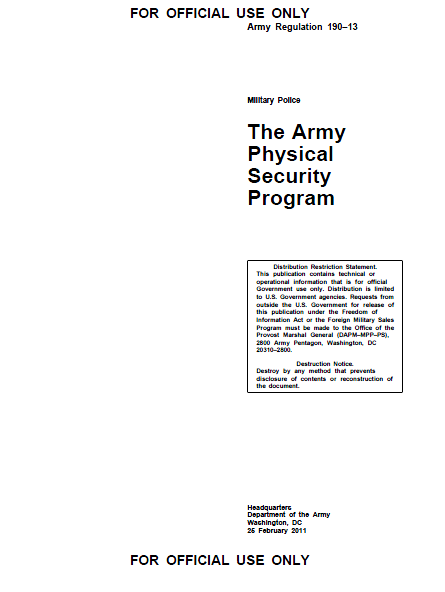The following version of U.S. Army Regulation 190-13 was posted to a public-accessible website associated with an Alaska-based construction company. A previous version of the document from 1993, labeled as “approved for public release”, was previously published by the Federation of American Scientists.
Army Regulation 190–13
- 59 pages
- For Official Use Only
- February 25, 2011
This regulation implements DOD 5200.08–R and DODI 3224.03. It prescribes policies, procedures, and guidance to plan and implement the Department of the Army Physical Security Program. It provides guidance concerning requirements for and use of physical security equipment; the appointment of physical security officers and inspectors; the conduct of physical security inspections and surveys; the management of physical security credentials; the management and use of identification cards and badges; restricted areas; access control for installations and stand-alone facilities; and security forces.
…
6–7. National Defense Areas
a. A restricted area may be established on non-Federal lands within the United States and its possessions and territories to protect classified defense information and DOD equipment or material. When this type of area is established, it will be referred to as a National Defense Area (NDA). Examples of a NDA would include nuclear and chemical event sites and aircraft crash sites.
b. Establishing a NDA temporarily places such non-Federal lands under the effective control of DOD and results only from an emergency event.
c. The senior DOD representative at the scene will define the boundary, mark it with a physical barrier, and post warning signs. Every reasonable attempt will be made to obtain the landowner’s consent and cooperation in establishing of the NDA. Military necessity, however, will determine the final decision regarding NDA location, shape, and size.
d. The authority to establish a NDA includes the authority to deny access to it. It also includes the authority to remove persons who threaten the orderly administration of the NDA. Any use of force employed to enforce this authority will be per AR 190–14.
…
8–11. Installation access control point security forces
a. The IACPs will be manned by armed security force personnel (Soldiers, DA civilian police, DA security guards, or contract guards) as permitted by applicable Federal, state, and territorial statutes, and SOFA.
b. Commanders will use HQDA (DAPM–MPP–PS) IACP staffing guidance for manpower considerations to determine the appropriate manpower for primary and secondary IACPs.
c. Security forces will be provided with—
(1) Adequate means of communications.
(2) Appropriate weapons and ammunition and trained in their care and use per AR 190–14.
(3) Personal protective equipment.d. Procedures will be established for each IACP, and will be reviewed at least annually and revised, as necessary.
e. Training and weapons qualification of security force personnel will be in accordance with applicable directives, AR 190–56 for all assigned DA police and DA guards, and the statement of work for contract security guards.
f. Training will also include—
(1) Recognition of sabotage-related devices and equipment that might be used against the installation.
(2) Use of devices to identify sabotage-related devices and equipment such as hand-held vapor tracers and vehicle and cargo inspection systems.
(3) Authorized forms of identification for access to the installation.

